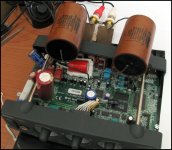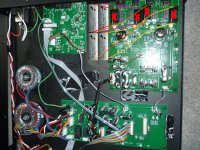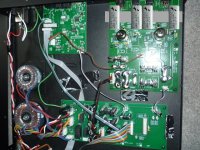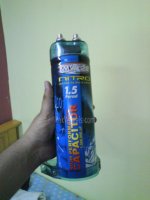I think the only way to fit bigger caps in the CARY 100t DAC would be to use long leadouts and sit the big caps on top of the other components?
Would that be a bad idea?
The size of the current caps is Ø 17 mm x L 31 mm, they use most of the available space!
😱

RESET THE QUESTION:
Does anyone know of an excellent output capacitor for the Cary 100t DAC?
Space is (at a push): Dia. 25mm X Len. 39mm.
Standard rating: 3,7Uf - 25v panasonic
Would that be a bad idea?
The size of the current caps is Ø 17 mm x L 31 mm, they use most of the available space!
😱

RESET THE QUESTION:
Does anyone know of an excellent output capacitor for the Cary 100t DAC?
Space is (at a push): Dia. 25mm X Len. 39mm.
Standard rating: 3,7Uf - 25v panasonic
Attachments
Last edited:
I think the only way to fit bigger caps in the CARY 100t DAC would be to use long leadouts
and sit the big caps on top of the other components? Would that be a bad idea?
Yes.
is there any reason why I can't chassis mount large caps in brackets?
Long flying leads with large loop areas around high frequency digital circuitry is a very bad idea.
Are these output coupling capacitors for the tube output buffer stages?
If they are power supply bypass capacitors, just don't do this at all.
Last edited:
Long flying leads with large loop areas around high frequency digital circuitry is a very bad idea.
Are these output coupling capacitors for the tube output buffer stages?
If they are power supply bypass capacitors, just don't do this at all.
Thank you!
I think they are the buffers (?) as they are mounted on the output board, not the power board, i.e. they're not power caps; CARY said they only run about 20volts max.
Is it a bad idea because the flying leads act like an antenna? Or something else?
cheers!
Long flying leads with large loop areas around high frequency digital circuitry is a very bad idea.
Are these output coupling capacitors for the tube output buffer stages?
If they are power supply bypass capacitors, just don't do this at all.
...just got this message from hifi collective:
Hi
You can do this. It is common practice when large parts are fitted.
Kind regards,
Nick Lucas
*******************************************************
Hi-Fi Collective Ltd:
tel/fax 00 44 (0) 1908 217202 //
join us at:
www.facebook.com/hificollective
https://www.hificollective.co.uk/catalog/components/capacitors.html
********************************************************
what's your thoughts please?
...just got this message from hifi collective:
Hi
You can do this. It is common practice when large parts are fitted.
Kind regards,
Nick Lucas
*******************************************************
Hi-Fi Collective Ltd:
tel/fax 00 44 (0) 1908 217202 //
join us at:
www.facebook.com/hificollective
https://www.hificollective.co.uk/catalog/components/capacitors.html
********************************************************
what's your thoughts please?
Very nice advice!!!I think u should use even bigger capacitor to ensure even bigger loop for your audio signal.It would be best that the caps have ther own separate chassis.

Is it a bad idea because the flying leads act like an antenna? Or something else?
Partly that. Also the cap itself is prone to pickup of stray fields with it having such a large surface area.
My advice would be as others have said... don't do it.
Dont use a capacitor rated for a few hundred volts on the output of your DAC. Buy some small WIMA poly caps and call it a day.
Note that in English "you can do this" means it is possible to do it. It does not mean that it is a good idea.
"Common practice" means that lots of people do it. It does not mean that it is a good idea.
Swapping a correct value cap for a much larger cap will probably do no harm, but it is unlikely to do any good. It may cause instability or hum/interference pickup due to the larger size having more stray capacitance and the longer leads having more loop area. Be aware that in some cases the extra interference picked up may not be recognised as such, but may be misinterpreted as extra 'detail' in the music. This could explain why these unwise modifications are so common.
"Common practice" means that lots of people do it. It does not mean that it is a good idea.
Swapping a correct value cap for a much larger cap will probably do no harm, but it is unlikely to do any good. It may cause instability or hum/interference pickup due to the larger size having more stray capacitance and the longer leads having more loop area. Be aware that in some cases the extra interference picked up may not be recognised as such, but may be misinterpreted as extra 'detail' in the music. This could explain why these unwise modifications are so common.
Depending on what the caps are doing the extra parasitic inductance will cause problems and if there is any high frequency noise on those shielded, un-twisted leads well...
NO
Also it looks like a bodge not a mod.
NO
Also it looks like a bodge not a mod.
I hear what you all say! i.e. 'loops', noise etc.
So, how about a bracket running above the output board? Roughly 20-25mm above the existing circuit board; then 'perch' the bigger caps on top of the bracket (bar) over the original cap locations on the output board?
This could conceivably mean that the flying leads WOULD NOT NEED TO BE EXTENDED, they may be long enough in stock form to reach the output board without any extensions at all!! In addition, the flying leads could also be INSULATED!
see illustration: please forgive inadequate photo editing - LOL!
So, how about a bracket running above the output board? Roughly 20-25mm above the existing circuit board; then 'perch' the bigger caps on top of the bracket (bar) over the original cap locations on the output board?
This could conceivably mean that the flying leads WOULD NOT NEED TO BE EXTENDED, they may be long enough in stock form to reach the output board without any extensions at all!! In addition, the flying leads could also be INSULATED!
see illustration: please forgive inadequate photo editing - LOL!

Attachments
I hear what you all say! i.e. 'loops', noise etc.
But you want to do it anyway 🙂
Then just go for it in the knowledge that the performance may be degraded. As long as you are happy with the result, then that is all that matters.
You haven't actually stated what you are trying to achieve.
Is there a problem you are trying to put right? Are you unhappy with the sound from the DAC? Is the Frequency Response poor?
Or are you just attempting to get into the Guiness Book Of Records for largest Caps used in a DAC O/P? If this is the case then can I suggest the ones in the attached Picture. You will need LOTS so as to get the Voltage right.
P.
Is there a problem you are trying to put right? Are you unhappy with the sound from the DAC? Is the Frequency Response poor?
Or are you just attempting to get into the Guiness Book Of Records for largest Caps used in a DAC O/P? If this is the case then can I suggest the ones in the attached Picture. You will need LOTS so as to get the Voltage right.
P.
Attachments
it looks like a bodge not a mod.
It looks like a bodge because it is an amateur photo edit 'mock-up' of the idea, NOT a professional photo edit. It is supposed to give contributors an idea of the concept only! In real life the photo would look different! (obviously!)

You haven't actually stated what you are trying to achieve.
Is there a problem you are trying to put right? Are you unhappy with the sound from the DAC? Is the Frequency Response poor?
Or are you just attempting to get into the Guiness Book Of Records for largest Caps used in a DAC O/P? If this is the case then can I suggest the ones in the attached Picture. You will need LOTS so as to get the Voltage right.
P.
thanx for the advice. What is it I'm trying to achieve? ...someone has put very cheap Monacor caps in the Cary 100t DAC (a dollar each! $) and I want to replace them with high quality caps because 'the cary' is a quality piece of kit; the only trouble is, all the quality caps seem massive and double the size of what is in there at the moment! The monacors are: Ø 17 mm x L 31 mm. Previous to this someone else had fitted Dynamicaps that were: Ø 25 mm x L 39 mm, but I'm uncertain how these fitted in the available space? It seems it may have been originally supplied with OEM/trade Panasonc caps that were replaced with some kind of ModWright caps (early on!)?
I have found these 'budget' caps that would fit the space allocated:
JEL-075 - 4.7uF 100V Jensen Axial Electrolytic Capacitor
https://www.hificollective.co.uk/cat...or-p-9208.html
001-0431: 3.9uF 400Vdc Jantzen Standard Z-Cap
https://www.hificollective.co.uk/cat...ard-z-cap.html
(MKP-060) - 3.9uF 250V Mundorf MCap MKP Capacitor
https://www.hificollective.co.uk/cat...or-p-8503.html
(KPQS/3.9/250) - AUDYN CAP MKP QS 3.90 MF / 400 VDC / 250 VAC 5% AXIAL capacitor
https://www.intertechnik.com/Shop/Cr...,en,7476,46758
...indeed there doesn't seem to be any high end quality caps that are small enough to fit in that space! Non of these are reviewed as being anything other than 'ordinary' (not extraordinary!). Do you know of any small very high quality caps?
Dan wemmer of 'CARY' said:
"sure! ...any of these should be OK as long as they fit the allocated space, there's no real voltage issue there (20 volts max.) that needs that high a voltage cap to be installed, it's just what those caps come as in manufacture, 100volt caps would easily suffice the purpose in this case!"
So that's it: I would like to fit very high quality caps.
But you want to do it anyway 🙂
Then just go for it in the knowledge that the performance may be degraded. As long as you are happy with the result, then that is all that matters.
Actually I asked if mounting them above their original board locations on a suspension bar and thus considerably REDUCING the loop area and insulating the flying leads would be a more suitable proposition than mounting off board (at the side) with long flying leads; that was the question? 🙁
- Status
- Not open for further replies.
- Home
- Source & Line
- Digital Line Level
- over sized caps?




